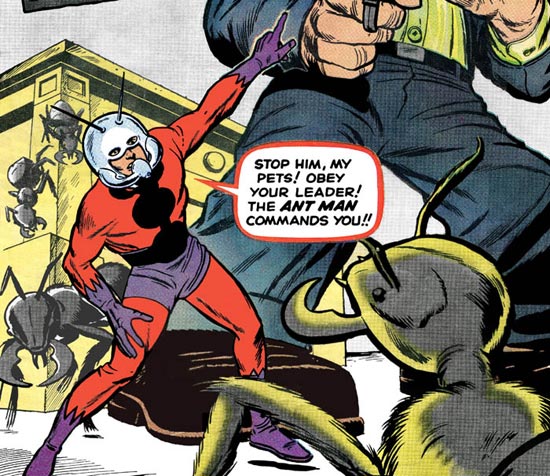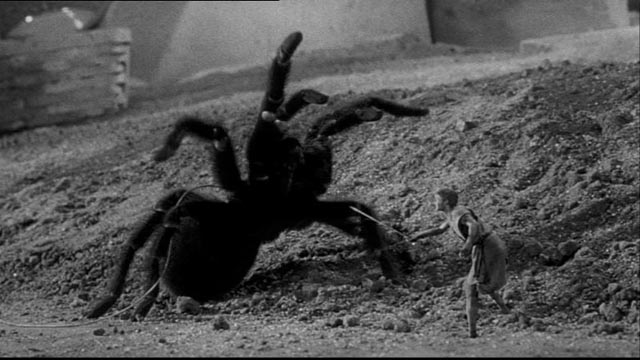You know the one, where you debate about which power you would really want to have, not just which would be cool but also practical or fun. Most people I think tend to choose flight, followed by the other more common choices, invisibility, super strength, super speed, and so on. Who in the history of ever has chosen 'the ability to shrink to the size of an ant'?
 |
| "I did." |
Ant-Man was always going to be a hard sell since his very existence always begged the simple question: how does shrinking make him in any way useful in a fight? No, really I want to know. This guy was on the Avengers with the Hulk and Thor, a raging unstoppable monster and a literal god. How could he be of any use?
The short answer? Not much, I guess? Even if you're going by his formidable ability to control a swarm of ants, it doesn't add much, aside from flame wars about whether Aquaman's ability to talk to fish is more useless or not, that is.
 |
| This is an actual thing that happened in an actual comic book. And that fact is one of the reasons I love comics so much. |
The shrinking thing was actually a quite popular sci-fi trope at the time. Well, to be fair it wasn't a trope just yet although the idea was floating around in the ether. Primarily from the 1957 film, The Incredible Shrinking Man, a movie which I doubt Stan Lee was unaware of. In the film, the main character is exposed to a mysterious radioactive gas which causes him to slowly but consistently shrink over the course of the film.
And how did Ant-Man originally control his shrinking again? Oh, yeah, that's right. With radioactive gas. I mean, I know radioactivity was all the rage back then due to the fear of the nuclear bomb and was the primary cause for the vast majority of Marvel superheroes at the time, but that seems like a little bit too close to 'heavily influenced by' (read 'kinda copied') territory.
 |
| Although somehow I don't think Paul Rudd's Ant-Man film will end with a climatic fight against a spider before resigning to his ever-shrinking fate. |
Now the thing is, I like Ant-Man as a character but I have to be specific which Ant-Man I like since there have been a couple of them (and no, Eric O'Grady doesn't really count). The first man to done the antennae was Hank Pym. Pym invented the size changing chemicals, Pym Particles, which allowed him to change size, go figure. He also developed the helmet that allowed him to communicate and control ants.
And Pym's early adventures in the 1960s are a great read since they really try so hard to make it seem like becoming real small and controlling ants is an useful superpower. It gets so contrived sometimes that the scenarios become utterly ridiculous, which, to be honest, is most of the charm of those early Ant-Man stories in old Tales to Astonish.
 |
| Wait... The bad guy dropped the gun and then Ant-Man told his ants to plug it up with honey so it couldn't be used again? Do ants even carry honey? Is that a thing ants do? Where did the honey come from?! |
However, the problem is that there are a number of issues with Hank Pym's character and history, most of which came after the Stan Lee's run with the character. One of the unique things about early Hank Pym Ant-Man is that for the majority of his career as a superhero, he is joined by his girlfriend Janet van Dyne who becomes his crime-fighting partner, the Wasp.
As Game of Thrones scribe, George R.R. Martin describes:
At a time when every other comic was playing the endless "romantic tension" card, or the older and hoarier "I must hide my secret from my girlfriend" trope, here was a man and a woman who adventured together, who loved each other without question, who even helped found the Avengers together... that was revolutionary in the early 1960s, like much of what Stan Lee did... (and sad to say, it would even be sort of revolutionary today).
 |
| Oh, so that's what shrinking powers are good for. |
Aren't they a lovely little couple? So tiny and cute walking under doors to fight crime and foil schemes together. They're even holding hand. Their very, very small hands. Adorable.
Of course, there is a bit of casual sexism in the depiction of Jane because of course there is. Often she was written in an overly romantic foolish girl way with her constant googly eyes for Hank, often for no reason other than the fact that she's a silly girl who's smitten and silly because she's a girl. Also, she would sometimes be incapable merely so he could save her or naive purely so he could dismiss her simply because she was a woman and boy, aren't women just the darnedest things? Am I right, fellas?
However, that was part of the time in which the comic was written, although it really feels as though she was written by a man who had never spoken to a woman before. But despite those criticisms, the Wasp was a hero in her own right who had quite a bit of agency and spunk for a female character at the time.
 |
| This panel was selected completely at random and totally wasn't intended to completely undermine my defense of the character depiction in the 1960s. |
I don't want to get too bogged down in Hank Pym since I've got some thinks to say about his successor, Scott Lang, who is the main Ant-Man in Marvel's latest cinematic offering, but you can't bring up Hank Pym online without bringing up his mental instability and wife-beating.
So, in an attempt to make Pym interesting or something, some writers decided that Pym would suffer from chronic insecurity which was exacerbated by his size changing powers where his shrinking was a metaphor for his feelings of inadequacy and his giant form was a front to cover up that insecurity. That's a pretty neat idea and most Marvel superheroes work as metaphors, the Hulk being the most obvious example, so it could have worked.
The problem is that it wasn't handled properly and made Pym rather unlikable as a result which culminated in his abusive relationship with Janet. That lead him to backhand her while trying to prove how much of a hero he is to the others by unleashing a bad robot on the Avengers that he would then save them from, which is not really what a hero should do, so minus marks for you, Hank.
 |
| Incidentally, he was calling himself Yellowjacket at the time since he changed his name about as often as he changed size. |
Far more capable people than me have discussed the sexism inherent in Hank Pym's character in length and you can find numerous articles about it online with a quick Google search, so let's move along to Scott Lang.
Quick backstory, Scott Lang is a reformed thief and electronics expert who stole Hank Pym's Ant-Man suit in order to rescue his daughter, Cassie, who had been kidnapped. After Hank learnt why Scott stole his suit, he let him keep it to fight crime since I guess he wasn't being an asshole at that stage of his crime-fighting career.
Okay, [spoiler] Cassie later becomes a superhero herself and is killed by Dr. Doom because reasons and Scott is grief-stricken and pissed off at Doom, wanting revenge. Cool, we're caught up to where I want us to be (even later [spoilers again] Cassie is brought back to life because comic books but that's not where I want to go with this).
 |
| THIS is where I want to go with this. |
In case you're unable to identify what exactly the awesomeballs you are looking at, that is Ant-Man fighting eyebrow lice. I could just end it there with no context and it would still be the greatest thing I've ever written. Ant-Man fighting eyebrow lice. What do you even say about that?
Well, firstly I could say how it's been my phone's lock screen for the past six months or so but more importantly is just how it highlights the sheer imagination and freedom in comics. Comics are one of those few mediums where their interior logic is such that ridiculous things like muscular men wearing tights with capes fly around or women wearing skimpy attire fight crime in impractical heels are considered normal.
But that is just the inventiveness and imagination to be found in Matt Fraction and Mike Allred's run on Fantastic Four and FF. I already spoke in some detail about Matt Fraction's excellent work with David Aja on Hawkeye so I think my love of Matt Fraction comics is abundantly clear.
 |
| Just to reiterate, he is infiltrating an art show on a celebrity's eyebrow. |
Fraction took a Scott Lang suffering from the lose of his daughter at the hands of Dr. Doom and put a group of children under his care to become his surrogate family. When the Fantastic Four go away on a time travelling journey to another dimension, Reed Richards puts Scott in charge of the Future Foundation.
The Future Foundation is Richards' great hope for the future of mankind containing the smartest and most gifted children in the world, from the princess of Wakanda to the clone of the evil mastermind Wizard, Bentley.
Now, to be fair, due to some wibbly wobbly timey wimey, the Fantastic Four were only supposed to be away for four minutes for their journey and Scott is only supposed to be in charge for those four minutes. I'll give you one guess how that turns out.
 |
| What?! Reed Richards was wrong? When has that ever happened before? |
I won't go into too much detail since I really think Fraction and Allred created a marvelous comic with a compelling story, which is admittedly light plot-wise but has so many great characters with real chemistry exchanging witty banter, and it really deserves to be discovered.
Allred's art is fantastic, beautifully coloured with interesting character designs and a deft touch that adds a real sense of warmth and precision. His art perfectly compliments Fraction's imaginative and snappy writing, coming together to form a wondrous expression of sequential art.
That's all I wanted to say about that really. Ant-Man is a hero with a complicated backstory and I can see why they opted for Scott Lang over Hank Pym in order to avoid the awkward legacy of wife-beating. That said, I really wish that means Paul Rudd's Ant-Man fights eyebrow lice in the movie.
References:
Ant-Man Wikipedia page
Ant-Man (Scott Lang) Wikipedia page
The Incredible Shrinking Man Wikipedia page
Me and Ant-Man - Not A Blog
Fantastic Four, Volume 1: New Departure, New Arrivals Review - WhatCulture
Fraction, Bagley and Allred Rein In ‘Fantastic Four’ and ‘FF’ [Double-Review] - Comics Alliance
FF, Volume 1: Fantastic Faux Review (Matt Fraction, Mike Allred) - ComicAlly
Post Script Plug:
Hey, do you like sounds put into some form of melody with words sung over them? Because I make music too. No, it's trueCheck out my music page here or listen to song I wrote about the internet or something called 'Avatars on Computer Screens' here. (By the way, those are hypertext links, that's why they're gold. Click on them to see to which magic land they lead.)
No comments:
Post a Comment